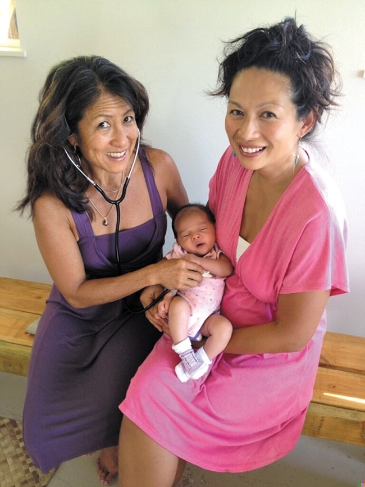Birthing The Natural Way
Dr. Lori Kimata
Naturopathic physician and midwife
Where did you receive your schooling and training?
I graduated from Punahou School. I earned my BA from UCLA and my doctorate in naturopathic medicine from National College in 1988. I am a family practice physician, with a specialty in obstetrics and midwifery. I have a group practice, Sacred Healing Arts, with locations in downtown Honolulu and Haleiwa.
mw-dih-082813-drlorikimata-2
How did you get involved with Hapai Hawaii?
As a licensed naturopathic physician and midwife of 25 years, I look for organizations whose purpose is to support birth professionals working toward the mother-baby initiative. Hapai Hawaii, the local chapter of Birth Network, is one such organization. I have been with Hapai Hawaii since its conception a few years ago, and I am one of the providers Hapai Hawaii refers people to when they are interested in exploring informed childbirth options.
What is the current national medical health perspective on vaginal birth versus cesarean?
The American College of OB/GYN states that vaginal birth is safer and healthier for both mother and baby. Research has indicated there are respiratory, digestive, immune and hormonal disruptions that can occur when birth is altered from its natural process. The recent International Birth Symposium held at the Honolulu Convention Center brought researchers from around the world to testify that deviating from nature’s course has serious repercussions (see primalhealth.org). The World Health Organization says that a healthy cesarean birth rate is 15 percent of overall births, and when it grows beyond that, we start losing more mothers and babies.
The cesarean rate in the U.S. is 34 percent on average, and this rate varies dramatically depending on the specific hospital and obstetrician. A study showed that one hospital had a rate of 89 percent cesarean deliveries. Hospital policies, insurance, liability concerns and choices that obstetricians and nurse midwives are often compelled to make, indicate more and more that birthing has become a business, as the film The Business of Being Born eloquently illustrates. Maternal health concerns also play a role in the increase in cesarean births. By combining poorer nutrition with stress and stagnant lifestyles, we are creating larger babies and less-fit mothers.
What has the standard practice been as far as birthing, and what changes would be optimal?
Standard practice is a very specific, continually evolving set of lab and screening diagnostics, which set up strict requirements for what is safe for mother and baby. Treatment is primarily based on these requirements, yet also is affected by so many other factors, such as fear of liability, institutional policies, special interest laws, doctor’s convenience, etc. The optimal change would be to place the mother and baby back at the center of the decisions made around birth, and to authentically create an environment of empowerment, trust and acceptance rather than fear. With evidence-based education and careful time spent with women and birthing families to enhance their overall health and their inner wisdom, we can encourage them to do what is true for them, and in doing so, we might find very different outcomes in birth. More women would be making informed choices about where, how and with whom they want to birth. There is an organization, Choices in Childbirth out of New York City, that is getting legislation passed in states to require doctors and institutions to make information public about rate of cesarean births, inductions and vaginal birth after cesarean.
What is the risk/benefit ratio of vaginal birth over cesarean, or vice versa?
The increased risks of having major abdominal surgery over a natural vaginal birth are obvious. The benefit of allowing the body to do what it is naturally meant to do is clear. We know that doing more cesareans has not resulted in better mother and baby outcomes. Research shows that in the U.S., where we spend more money on birthing than anywhere else, the cost of a birth in our country being the highest in the world – we do not have better outcomes for mothers or babies!
Performing major abdominal surgery for a natural process our bodies were designed to do needs to be a last resort. Sometimes a C-section is needed because something catastrophic is happening, like placenta abruptia or cord prolapse. Other times, maternal health might be compromised to a point of being dangerous for baby or mother (preeclampsia) and all other means of correcting this problem already have been exhausted. There may be some true fetal or maternal distress scenarios that cannot be resolved by hydration, position change, stress management or natural oxytocin enhancement. A genetic or developmental problem also may indicate a C-section. However, these cases are much less common than we think.
Can you say something about the Rally for Change/Rally to Improve Birth on Labor Day (Sept. 2, 10 a.m. to noon, Kapiolani Park, improvingbirth.org)?
The intention is to bring awareness to a situation that is ready for change. The rally is an international movement to empower women and support them in embracing their basic human right to gain full and accurate information about their care, make informed decisions, and then be treated with respect, dignity and compassion for these choices.






